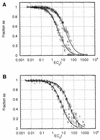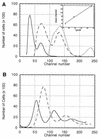Genome size, complexity, and ploidy of the pathogenic fungus Histoplasma capsulatum
- PMID: 9852017
- PMCID: PMC107776
- DOI: 10.1128/JB.180.24.6697-6703.1998
Genome size, complexity, and ploidy of the pathogenic fungus Histoplasma capsulatum
Abstract
The genome size, complexity, and ploidy of the dimorphic pathogenic fungus Histoplasma capsulatum was determined by using DNA renaturation kinetics, genomic reconstruction, and flow cytometry. Nuclear DNA was isolated from two strains, G186AS and Downs, and analyzed by renaturation kinetics and genomic reconstruction with three putative single-copy genes (calmodulin, alpha-tubulin, and beta-tubulin). G186AS was found to have a genome of approximately 2.3 x 10(7) bp with less than 0.5% repetitive sequences. The Downs strain, however, was found to have a genome approximately 40% larger with more than 16 times more repetitive DNA. The Downs genome was determined to be 3.2 x 10(7) bp with approximately 8% repetitive DNA. To determine ploidy, the DNA mass per cell measured by flow cytometry was compared with the 1n genome estimate to yield a DNA index (DNA per cell/1n genome size). Strain G186AS was found to have a DNA index of 0.96, and Downs had a DNA index of 0.94, indicating that both strains are haploid. Genomic reconstruction and Southern blot data obtained with alpha- and beta-tubulin probes indicated that some genetic duplication has occurred in the Downs strain, which may be aneuploid or partially diploid.
Figures





Similar articles
-
[Intraspecific chromosomal variability in human pathogenic fungi, especially in Histoplasma capsulatum].Rev Iberoam Micol. 2004 Dec;21(4):168-76. Rev Iberoam Micol. 2004. PMID: 15709795 Review. Spanish.
-
The arbuscular mycorrhizal fungus Glomus intraradices is haploid and has a small genome size in the lower limit of eukaryotes.Fungal Genet Biol. 2004 Feb;41(2):253-61. doi: 10.1016/j.fgb.2003.10.011. Fungal Genet Biol. 2004. PMID: 14732270
-
Characterization of alpha and beta tubulin genes in the dimorphic fungus Histoplasma capsulatum.J Gen Microbiol. 1989 Jul;135(7):1817-32. doi: 10.1099/00221287-135-7-1817. J Gen Microbiol. 1989. PMID: 2614394
-
Identification and characterization of a phase-specific, nuclear DNA binding protein from the dimorphic pathogenic fungus Histoplasma capsulatum.Infect Immun. 1998 Aug;66(8):3867-73. doi: 10.1128/IAI.66.8.3867-3873.1998. Infect Immun. 1998. PMID: 9673274 Free PMC article.
-
The importance of molecular analyses for understanding the genetic diversity of Histoplasma capsulatum: an overview.Rev Iberoam Micol. 2014 Jan-Mar;31(1):11-5. doi: 10.1016/j.riam.2013.09.013. Epub 2013 Nov 16. Rev Iberoam Micol. 2014. PMID: 24252830 Review.
Cited by
-
Chromosomal copy number variation, selection and uneven rates of recombination reveal cryptic genome diversity linked to pathogenicity.PLoS Genet. 2013;9(8):e1003703. doi: 10.1371/journal.pgen.1003703. Epub 2013 Aug 15. PLoS Genet. 2013. PMID: 23966879 Free PMC article.
-
Molecular detection of Histoplasma capsulatum var. capsulatum in human clinical samples.J Clin Microbiol. 2003 Apr;41(4):1753-5. doi: 10.1128/JCM.41.4.1753-1755.2003. J Clin Microbiol. 2003. PMID: 12682178 Free PMC article.
-
Deletion of the Stress Response Gene DDR48 from Histoplasma capsulatum Increases Sensitivity to Oxidative Stress, Increases Susceptibility to Antifungals, and Decreases Fitness in Macrophages.J Fungi (Basel). 2021 Nov 18;7(11):981. doi: 10.3390/jof7110981. J Fungi (Basel). 2021. PMID: 34829268 Free PMC article.
-
Agrobacterium tumefaciens integrates transfer DNA into single chromosomal sites of dimorphic fungi and yields homokaryotic progeny from multinucleate yeast.Eukaryot Cell. 2002 Dec;1(6):895-905. doi: 10.1128/EC.1.6.895-905.2002. Eukaryot Cell. 2002. PMID: 12477790 Free PMC article.
-
Loop-mediated Isothermal Amplification and nested PCR of the Internal Transcribed Spacer (ITS) for Histoplasma capsulatum detection.PLoS Negl Trop Dis. 2019 Aug 26;13(8):e0007692. doi: 10.1371/journal.pntd.0007692. eCollection 2019 Aug. PLoS Negl Trop Dis. 2019. PMID: 31449526 Free PMC article.
References
-
- Ausubel F M, Brent R, Kingston R E, Moore D D, Seidman J G, Smith J A, Struhl K. Current protocols in molecular biology. New York, N.Y: John Wiley & Sons; 1993.
-
- Berliner M D. Primary subcultures of Histoplasma capsulatum: I. macro- and micromorphology of the mycelial phase. Sabouraudia. 1968;6:111–118. - PubMed
-
- Britten R J, Graham D E, Neufeld B R. Analysis of repeating DNA sequences by reassociation. Methods Enzymol. 1974;29:363–418. - PubMed
-
- Dressler L G, Seame R L C, Owens M A, Clark G M, McGuire W L. DNA flow cytometry and prognostic factors in 1331 frozen breast cancer specimens. Cancer. 1988;61:420–427. - PubMed
Publication types
MeSH terms
Substances
Grants and funding
LinkOut - more resources
Full Text Sources

